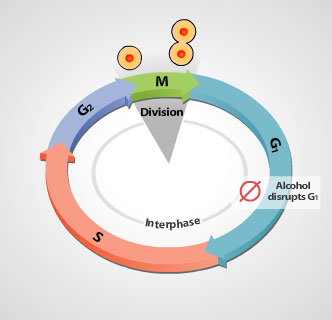Cell growth is an elegantly coordinated series of steps; any of these steps are subject to interference by drugs and chemicals. Specifically, alcohol disrupts neural stem cell growth and division. Alcohol causes cells to progress more slowly through the cell cycle. The cycle consists of 4 major stages, during which cells grow and produce new proteins (G1), synthesize DNA (S), produce new organelles (G2) and divide by mitosis (M). The most susceptible stage of the cell cycle is the G1 phase where alcohol inhibits the transcription and translation of genes that regulate the remaining steps of the cell cycle. The result is that cells won’t proceed into S phase to duplicate their chromosomes in preparation for cell division. With a reduction in cell proliferation, the loss of neurons within the hippocampus can lead to significant learning and memory problems. The loss of neurons may explain the smaller hippocampus observed in the brains of adolescents with alcohol use disorder (read on!).
Learn more about cell growth and division.
Learn more about gene transcription and translation.
 Figure 3.4 Alcohol affects stem cells during G1 when DNA transcription and translation to new proteins takes place. Alcohol disrupts the duplication of DNA in S phase, leading to reduced mitosis. Move your cursor over each phase to see what occurs.
Figure 3.4 Alcohol affects stem cells during G1 when DNA transcription and translation to new proteins takes place. Alcohol disrupts the duplication of DNA in S phase, leading to reduced mitosis. Move your cursor over each phase to see what occurs.
The pattern by which adolescents drink alcohol may have a large effect on the drug’s ability to damage the adolescent brain. Adolescents often binge drink or consume at least 5 drinks over a several hour period. This mode of drinking can achieve blood alcohol concentrations (BACs) that will block the growth of neural stem cells. Even one month after a single binge episode neurogenesis remains diminished.
 Figure 3.5 A single dose of alcohol in rats (equivalent to a dose that is highly intoxicating in a human) decreases the proliferation of neural stem cells in the hippocampus by 40% 5 hours later (left panel). After 4 weeks the actual number of new hippocampal neurons is decreased by more than 50% (right panel). Adapted from Crews & Nixon; http://pubs.niaaa.nih.gov/publications/arh27-2/197-204.htm
Figure 3.5 A single dose of alcohol in rats (equivalent to a dose that is highly intoxicating in a human) decreases the proliferation of neural stem cells in the hippocampus by 40% 5 hours later (left panel). After 4 weeks the actual number of new hippocampal neurons is decreased by more than 50% (right panel). Adapted from Crews & Nixon; http://pubs.niaaa.nih.gov/publications/arh27-2/197-204.htm